![]()
|
|
Peeler Crab
20 Steps to the fishy delight |
| Many of the terms used herein are not true anatomical terms, but are for ease of understanding |
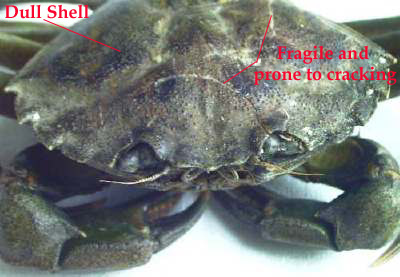 |
The most common crab used for fishing is
the Common Shore Crab Carcinus maenas, although other species are
used, depending upon location and availability.
The common shore crab is identified by the three blunt serrations
or teeth of the top shell (carapace) between the eyes, and 5 sharp shell
teeth on either side of the body. The shell then tappers at almost 45 degrees
back to a square set end. The result is that the shell is
broader than it is from front to back. Peeler Crabs, are simply crabs that are under going a moult, to allow growth towards maturity ... So how do you tell if your crab is a peeler ..... The shell tends to become dull and fragile, and is prone to cracking .... the shell may also feel "soapy" to the touch...... |
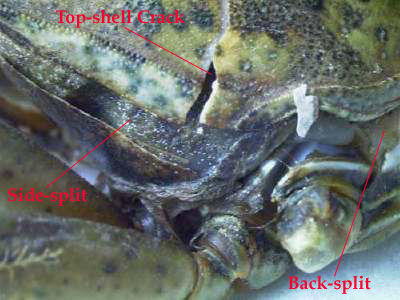 |
The component parts of the shell start to be forced apart as the crab takes in water into the underlying fleshy tissue. This results in tell tale signs of side splits, back edge splits, and indeed cracking of the top shell. |
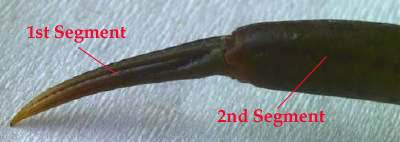 |
But such features may only manifest themselves once the peeling process is well underway .... the use of the first or terminal segment of one of the walking legs, tends to be a reasonably good way of telling a hardback from softback if your unsure... |
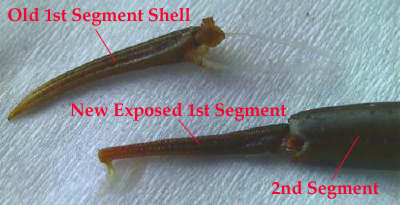 |
Take a firm grip of both the 1st and second segments
of the hind leg, and twist about 45 degrees, first one way, and then the
other .... having broken the connective tissue holding the two together,
pull slowly but firmly apart .... If it's a peeler then you should have an empty 1st segment shell, and a new freshly exposed fleshy 1st segment still attached to the second segment. If it's a hard back, then the 1st segment comes away whole, and leaves just a white cartilage stump joined to the second segment. |
 |
Having established that what you have is a peeler,
you now need to prepare it.......
Kill the crab, by inserting a knife blade between the eyes....... Now turn the crab over, so you can clearly see the leg joints, and the leg/body sockets .... The sex of the crab may have some bearing upon it's preformance as a bait, although opinions differ. Male crabs (cocks) are easily recognised by the fact that the tail plate ends in a pointed V, whilst the Female crabs (hens) tail plate ends in a more broard and rounded form. Male crabs are often favoured by anglers on the basis that they tend to be larger / juicier, and will not be mobbed by other male crabs attracted to it .. unlike the female with her sexually attracting pheromones. On the otherhand, someanglers believe that the hens out fish the cocks ... take your pick!!!! |
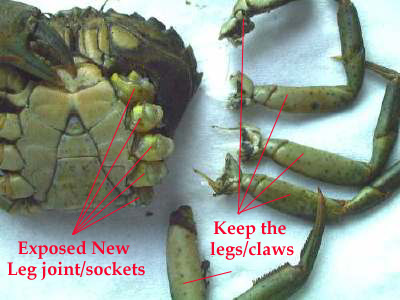 |
Twist the legs off at the leg joint/socket, much like
you did with the first and second segments to test if it was a peeler
..... twist one way about 50 degrees, and then the other way .... pull with
care, and try not to wrench the socket/joint or you will tear the body flesh
that will pull away with it.....
Keep the whole legs and claws .. they make useful baits as well, so we'll deal with those after the main body is dressed. |
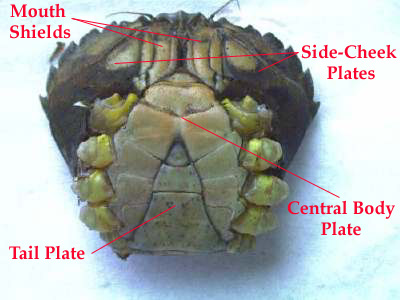 |
Once you have removed the legs and claws you should
be left with the main body to prepare.....
The next sequence of tasks are
1. Removal of the tail plate shell so lets get to it...... |
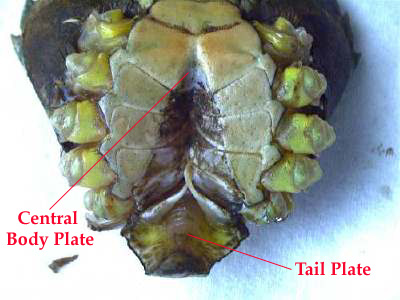 |
The tail plate is in fact an extension of the abdomen
or belly that is tucked under itself , and thus covers about a third of the
central body plate below.... wish I could do that with my beer gut ;-)
Using your fingernail, lift the top edge of the tail plate .. ie the pointy end ... and pull it back ..... work your fingers gently over it and flex it...... this helps to separate the flesh from the tail plate shell...... |
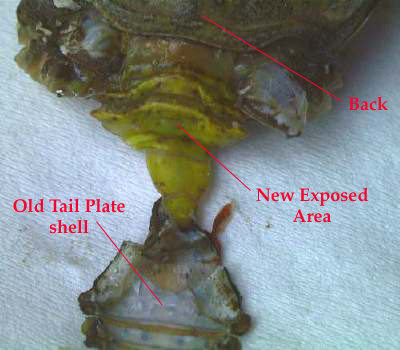 |
Turn the crab over ..... find the start of the tail plate shell .. the broad end .. just under the back of the top shell .. it's an area of horizontal ridges.... gently pick it away from the flesh, and then it should peel off in one whole section towards the tip...... |
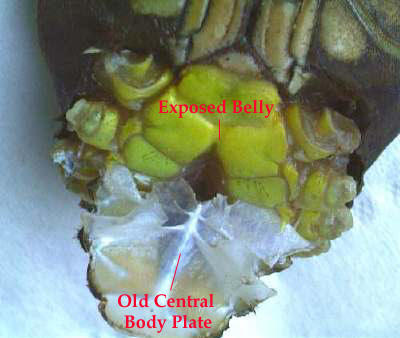 |
OK... well flip the crab back on it's back.... locate the top of the central body plate .... it's the V structure that intersects with the mouth shields .... gently pull it up, and then work down lifting the whole plate away .... the tricky bit is to get the cartilage plates between the body segments to lift at the same time ... or else you may have to pick at the soft flesh to remove it .. which both takes time, and degrades the structure of the body mass...... oh and by this time your fingers are probably very sticky, which makes life so much more fun ;-) |
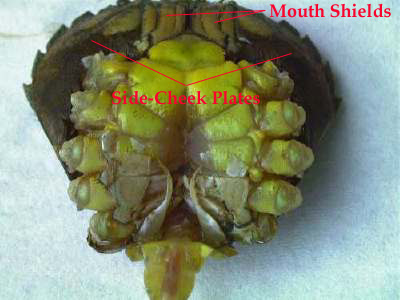 |
Well your crab should now be looking something like this .. if there are few bits of broken shell left you can remove them at the end... |
|
The side cheek plates are the next to be removed .. and are often the easiest part to do so on the whole crab.... |
|
Next remove the mouth shields ..... twist and gently pull .. if your lucky then the soft flesh will remain behind .. but more often then not, they are lost .... don't loose any sleep over it.. you already have more than enough juicy crab flesh to use........ |
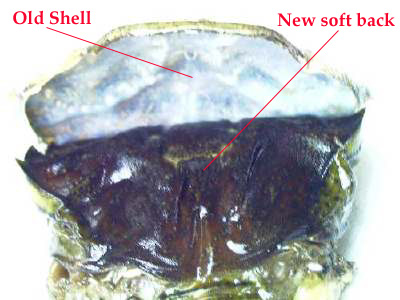 |
Flip the crab over so that the top and back face you
..... gently insert your finger or thumb nail under the back lip
of the top shell ..... apply a gentle amount of pressure to the flesh below
using your other hand and lift the shell, pivoting at the front edge
with the eyes.... something very satisfying when you've reached this
stage ....
once the shell is at 90 degrees to the back, pull it away from the eyes .... |
|
Now turn the crab face on .. using your fingernail, insert and pull down the mouth region .... you should expose the white jaw plate .... gently wiggle it from side to side to loosen it, and then pull it out.... sort of a crustacean dental job ;-) |
 |
Looking good .... but if you run your finger over the
fleshy back of the crab, you will feel two sharp horny projections ..
they have to go......
Turn the crab side on .... lift the flesh upper layer ... in doing so, you should expose the horny side plate .. gently wiggle it, and remove it..... Below it you will find a series of finger like projections .. sort of greyish brown in colour ... these are the gills ... although more commonly known as the "lungs", or dead mans fingers ... most people remove them .. either cut them off, or pinch then off with your fingernails... Pull the fleshy top gently back into place, turn the crab 180 degrees and do the otherside ..... If you intend to freeze the crab for later, then you MUST, remove the "lungs". |
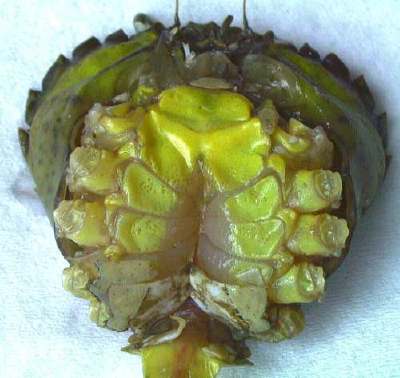 |
You should now have one sexy juicy crab, ready to be mounted on a nice wide gaped hook... oh but hang-on what about those legs and claws..... glad you asked..... |
 |
Starting with the 1st segment.... twist and
remove the covering shell as you have done before ...... now do
the same with the second segment, as the leg is tapered, slide the segment
shell over the fleshy 1st segment .. The 3rd segment should come off in the same style .. however, it's often not the case, and you may have to gently crack it open with your fingernails and peel it clean .. the 4th segment should be lightly twisted and pulled in the opposite direction of the tip ..... good .. only another 7 to go ....... |
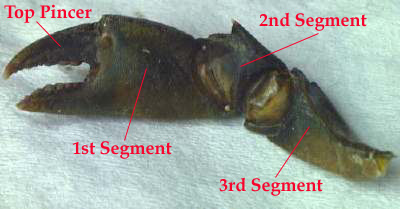 |
The claws are quite fleshy .. more so than the
legs and are thus worth the time to clean...
Gently twist off the the shell from the 3rd segment ... Break the top pincer by lifting upwards, and it should then be pulled clean from the it's flesh pincer. Apply point presser using your finger nails to the first segment to crack it open ... crack open and peel the second segment as well ..... Repeat |
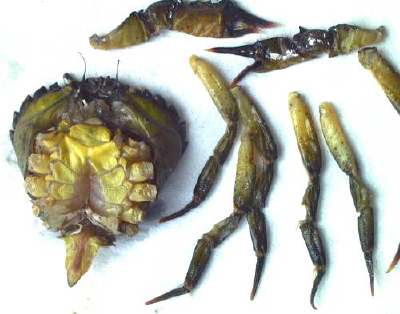 |
The finished article ..... phew
Have fun...... I'll do a series on mounting it on the hook when I get the chance.... just remember to try and use short shanked hooks .. and knitting elastic if your going to use it .. only needs 6 to 8 turns .. rather than being embalmed in the stuff :-) |
Return to the home page of the UK Sea Fishing Diary